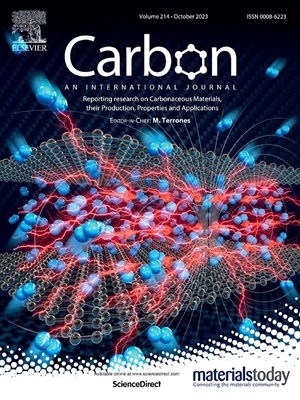碳氮聚合物在纳米结构上调控激子的产生和转移,用于光催化过氧化氢演化和乙醇选择性氧化
IF 11.6
2区 材料科学
Q1 CHEMISTRY, PHYSICAL
引用次数: 0
摘要
光生载体的高效生成和快速转移是提高光催化反应性能的关键。在本研究中,将焦苯二酸酐作为电子受体嵌入多孔的g-C3N4中,构建D-A聚合物(即P-g-C3N4-Pa)。苯二酸酐的引入有效地改善了π→π∗和n→π∗的电子跃迁,提高了光利用效率。焦苯二酸酐与g-C3N4电位差的显著性削弱了激子效应产生自由电子和空穴。因此,P-g-C3N4-Pa在光催化合成H2O2中表现出优异的性能。原位光谱和电化学测试表明,双电子氧还原反应是反应的主要途径,O2•-是反应的关键中间体。嵌入的焦二苯二酸酐也提高了g-C3N4对O2的捕获能力,从而克服了限速步骤,促进了∗O2的产生。此外,g-C3N4上的光生孔可以选择性氧化乙醇生成具有较高经济价值的乙醛,所生成的质子有利于H2O2的生成。重要的是,在乙醇存在的可见光照射下,P-g-C3N4-Pa上H2O2的最高产率为5600.8 μmol g−1•h−1。本文章由计算机程序翻译,如有差异,请以英文原文为准。

Regulating exciton generation and transfer upon nanoarchitectonics with carbon nitrogen polymer for photocatalytic hydrogen peroxide evolution coupled with ethanol selective oxidation
Efficient generation and rapid transfer of photogenerated carriers are crucial for the improvement of photocatalytic reaction. Herein, pyromellitic anhydride as electron acceptor is embedded into porous g-C3N4 for constructing D-A polymer (namely P-g–C3N4–Pa). The introduction of pyromellitic anhydride effectively improves π→π∗ and n→π∗ electronic transitions, enhancing light utilization efficiency. Significant potential difference between pyromellitic anhydride and g-C3N4 weakens excitonic effect to produce free electrons and holes. Thus, P-g–C3N4–Pa exhibits excellent performance in photocatalytic H2O2 synthesis. In-situ spectroscopy and electrochemical tests reveal that two-electron oxygen reduction reaction is major pathway, and O2•‒ is a key intermediate. Embedded pyromellitic anhydride also boosts capture capability of g-C3N4 for O2, thereby overcoming rate-limiting step to promote ∗O2 generation. Furthermore, photogenerated holes located on g-C3N4 can selectively oxidize ethanol to produce acetaldehyde with high economic value, and generated proton facilitates H2O2 generation. Importantly, the highest yield of H2O2 is 5600.8 μmol g−1•h−1 over P-g–C3N4–Pa under visible light irradiation in the presence of ethanol.
求助全文
通过发布文献求助,成功后即可免费获取论文全文。
去求助
来源期刊

Carbon
工程技术-材料科学:综合
CiteScore
20.80
自引率
7.30%
发文量
0
审稿时长
23 days
期刊介绍:
The journal Carbon is an international multidisciplinary forum for communicating scientific advances in the field of carbon materials. It reports new findings related to the formation, structure, properties, behaviors, and technological applications of carbons. Carbons are a broad class of ordered or disordered solid phases composed primarily of elemental carbon, including but not limited to carbon black, carbon fibers and filaments, carbon nanotubes, diamond and diamond-like carbon, fullerenes, glassy carbon, graphite, graphene, graphene-oxide, porous carbons, pyrolytic carbon, and other sp2 and non-sp2 hybridized carbon systems. Carbon is the companion title to the open access journal Carbon Trends. Relevant application areas for carbon materials include biology and medicine, catalysis, electronic, optoelectronic, spintronic, high-frequency, and photonic devices, energy storage and conversion systems, environmental applications and water treatment, smart materials and systems, and structural and thermal applications.
 求助内容:
求助内容: 应助结果提醒方式:
应助结果提醒方式:


